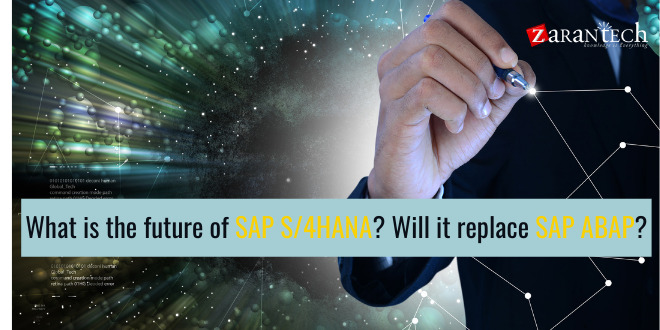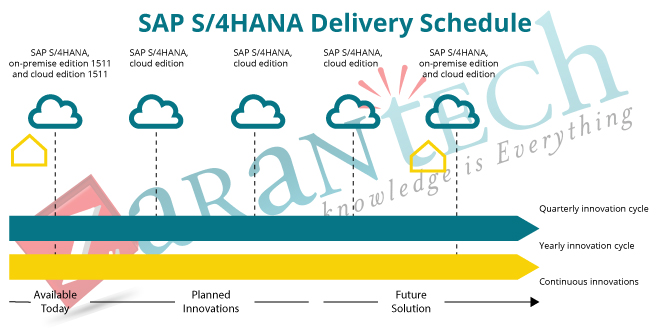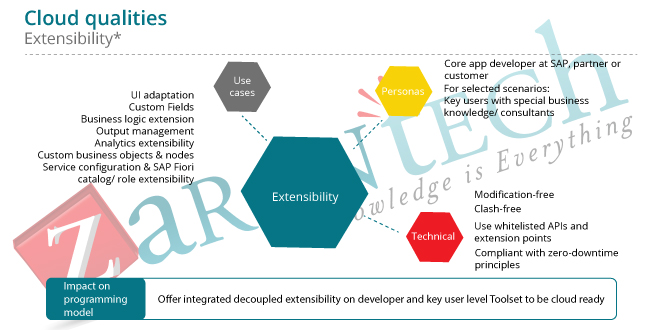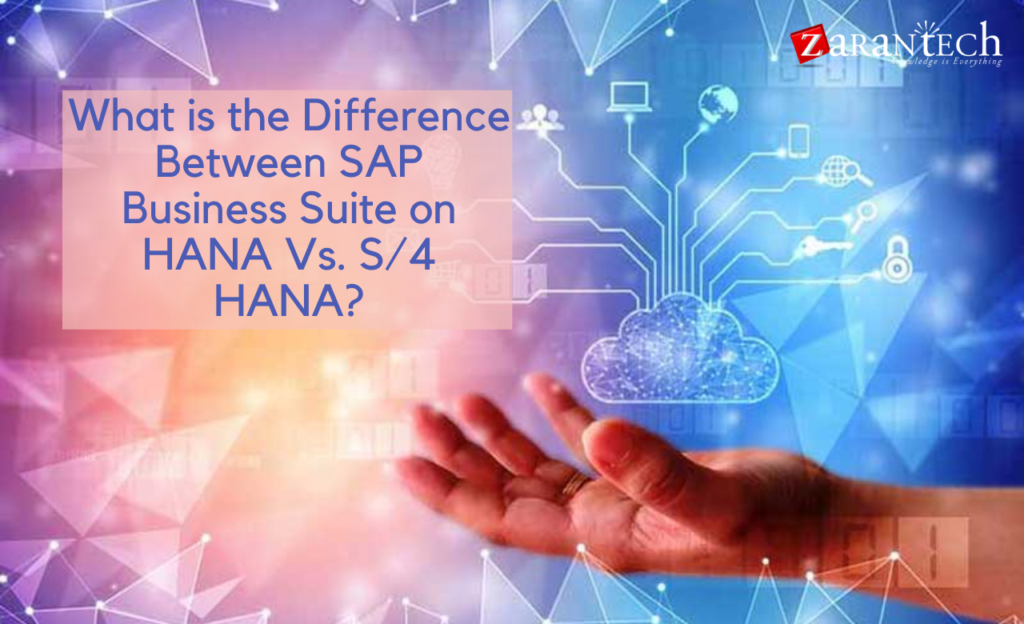What is the future of SAP S/4HANA? Will it replace SAP ABAP?
Category: SAP ABAP, SAP S/4HANA Posted:May 31, 2017 By: Ashley Morrison
It is worth noting that SAP S/4HANA is not restricted to being an accelerated in-memory database with numerous product innovations being delivered in the S/4 suite as well. The sleek and brand new Fiori front end comes along with plenty of intelligent integration points, with a significant reduction in the number of tables used in Finance and also in Logistics. The application like appearance that is the look and feel makes it stand out further making it look modern, with it being easily accessed through a smartphone.
The available to promise or ATP is said to be multi-faceted, convenient to use and even intuitive, making the creation of a sales order mean a lot more than it used to. The analytics are side by side on the very same presentation layer along with graphs and similar informative visuals. One does not need to visit a BI system any longer for reports, detailed or otherwise, and the reports are also in real-time with financial closing supposed to be a highly accelerated and even much easier.
S/4HANA is also able to accommodate SRM and CRM also on the same box minimizing maintenance and even integration costs. S/4HANA also enables Internet of Things or IoT scenarios, and native integration for hybrid scenarios with Fieldglass, Ariba, SuccessFactors, and Hybris. S/4HANA can be deployed in-house or on the Cloud.
Even though S/4HANA seems expensive at the outset, it is touted by all market experts to be the new norm. An example of this is the Google Instant feature in the Google Search Engine which predicted search topics before even completing typing. People will see the capabilities of S/4HANA as a paradigm shift and will accept and embrace the changes as the future, sooner than later.
Checkout the Article-SAP HANA, S/4HANA, and S/4HANA Finance in a Nutshell

The Future of SAP- An Outlook for SAP and SAP S/4HANA
SAP has remained a dominant player in the enterprise software arena, customers relying on SAP technology to operate their enterprise runs to the hundreds of thousands as it stands currently. Growing customer demand has seen SAP repositioning itself as a digital transformation platform. SAP’s flagship product S/4HANA is aiming to be the core of modern, digital businesses that are agile with SAP. SAP has also doubled down on Cloud solutions. Recently SAP has claimed around Euro 3 billion in cloud revenue for 2016 out of its total Euro 22 billion in revenues. Already, there exist around 5,400 customers for the S/4HANA product as of 2016.
S/4HANA Features:
Headless “Digital Core“
SAP’s major advances in diverse technological advances have begun to see a future where the requirement for a user interface through a screen or a device will soon become the exception, instead of the rule for the digital core. The advances in technology referred to here are:
- Real-time Integration
- Cost-effective Sensors
- Predictive Algorithms
- Machine Learning
- Voice Recognition or Pervasive Mobility
Introducing these capabilities to the digital core of the software product will result in making logging on to SAP almost completely redundant. In its place individuals and organizations will respond to alerts about particular business scenarios that require to be addressed, which will regulate the smooth running of business processes. The analogy for comparison here is that, just like an automated self-driving car, SAP is shooting for something similar in the form of a self-driving Digital Core. This can be brought into fruition through these advances:
Real-Time Integration
The primary foundation for such automation centered Digital Core is the requirement for detailed real-time integration of both data and transactions, in order to collate the real world with the digital one. Also, it will be needed to eliminate the need for anyone to enter transactions into SAP. This will, in turn, need three primary building blocks- the first being high-quality data, the second being a clearly defined mapping between the target and source systems. And the third is a strong and fault tolerant integration landscape.
Once such building blocks are established, then and only then can one begin to construct smart solutions capable of reacting to what is actually occurring in real-time.
Sensors on Everything
The cost of sensors and inexpensive tags such as RFIDs coming down makes it possible to create a detailed digital record of events occurring in the actual world.
Such data can be related to physical goods such as ship containers, but this can even be applied to just information which can be automatically gathered from sales teams or it even can be in the form of email exchanges and site visits such as the ones for engineer recording visits and parts consumed and more. It can also be from existing customers, depending on the activity and location. When all such data along with the appropriate security checks is integrated into the systems in question, one can enable automated algorithms to stand the best chance of taking the next step in issue resolution when anomalies are detected.
Predictive Algorithms
After organizations acquire tons of high-quality data in real time, predictive algorithms are necessary to power predictive analytics. The right forecasts and predictions can enable organizations to successfully peer into the future and recognize potential problems before they are realized as real ones. It is at this stage that one can make the right personnel aware of potential problems or pass it on to automated processes which will compensate for the potential issues. An excellent example for this is the expediting of purchase orders for materials where one predicts shortages.
Machine Learning
When one considers delegating the management of business situations to algorithms capable of learning the types of decisions which are selected based on which decisions will bring forth the best outcomes. This will need the use of machine learning where computing power can take over what are known as fuzzy tasks which could only be previously handled by manpower.
Voice Recognition/Pervasive Mobility
When the load for machine learning algorithms goes beyond the capacity to handle, the algorithms will seek real-time input in the form of real-time feedback inserted into the process. This can be in the form of a social media feedback or any other online feedback. Such feedback can even be utilized to, in a way, train the machine learning elements to execute the decision automatically in the future.
S/4HANA- A Consultants Guide
Introduction and purpose
SAP products offer similar functionality which might lead to confusion amongst consultants and consumers alike. Therefore it is worth considering the direction that SAP is headed, in an effort to aid fresh SAP consultants and future SAP consultants.
A bit of background
SAP is the biggest ERP player in the market, with its ERP products evolving over the past few decades and with it being the single most integrated business solution implementation. With global companies across various industries and verticals using SAP solutions, a lot of career opportunities are available for a massive number of highly paid consultants.
The SAP package is integrated with nature and needs a consolidated effort from several professional coming with in-depth business knowledge and skill-sets in varied business areas. These areas can range from manufacturing, procurement, quality finance, warehouse, service and a whole lot more. There is also a need for consultants with the in-depth technical knowledge to bridge the gaps in standard SAP solutions and also used to customize the solution. There is also a need for system admins and staff capable of administering security such as security consultants.
Conventionally, enterprises hired consulting firms which were also known as system integrator to comprehend their business process and bring in consultants with highly focused skillsets able to comprehend their business processes and configure and design the future SAP systems and even train personnel.
Advent of new generation SAP products- S/4HANA, Cloud
SAP has consistently come up with brand new and innovative technologies to lead the host of ERP providers existing in the market. The current focus of SAP also includes the new S/4HANA which aims to conquer the IT market.
What is HANA?
SAP conventionally has operated on databases that were not owned by SAP itself. Every SAP installation was done before HANA was done using its competitor’s databases. HANA is being hailed as SAP’s proprietary cutting edge database which is column-oriented and uses in-memory technology to store data. It also offers real-time analytics.
What it means to be SAP Consultants?
SAP is implementing massive changes on the way to creating brand new markets for the next generation products, which sometimes leaves customers confused with an accelerated pace of changes and the series of products presently available with functionalities that overlap. This will lead to a higher level of difficulty for customers to make the right choices.
This provides a massive challenge for SAP consultants in terms of catching up with the pace set by SAP and comprehend the latest product offerings to provide customers with the right information and even guide them in making the optimal choice. The take away from this is that core businesses processes are in reality powered by the industry and would, in essence, stay the same regardless of the advancements in technology. The present need is for SAP consultants to invest in up-gradations of skills since the majority of the effort in comprehension of the technology involved in the newly released products, their functionalities and features.
Career in SAP ABAP Programming
SAP ABAP is among the several application-specific fourth-generation languages which offer abundant career opportunities for SAP ABAP programmers. Initially developed as a reporting language for SAP R/2, ABAP was later used to develop the platform for SAP R/3. ABAP was developed with the intent to generate reports as per the needs of the customer. But as it stands today ABAP cannot be utilized by professionals who are not programmers and requires a good understanding of relational database, object-oriented programming which are to be augmented with considerable programming skills needed for the creation of ABAP programs.
ABAP is provided with support from the latest version of NetWeaver, which is the development platform of SAP. This finally implies that ABAP won’t be utilized as a programming language for SAP fundamental functions and several other applications in the near future. This fact will make SAP ABAP programmers a high-value asset for all Enterprises looking to contribute on a large scale in the enhancement of ERP support for the optimal functioning of the Enterprise. It is a well-known fact that SAP is known as the world’s largest ERP service provider by its customers and competition as well. This makes ABAP programming the most sought out skill by SAP users and SAP channel partners.
It is of Paramount importance to comprehend the expectations from the perspective of an SAP ABAP programmer by people who recruit them. ABAP is capable of interacting with the centralized database SAP ERP, also on every ERP form, there is a command window that is accessible by users and can execute ABAP commands in run time. This particular feature enables an ABAP programmer to undertake the development of applications that can return data from central databases as per specified parameters.
With several small and medium enterprises running the business by utilizing SAP products, for instance, financial advisors of massive operations utilizing SAP FICO. Here ABAP programmers can aid them by personalizing and customizing the module of SAP according to customer requirements. The best way for ABAP programmers to build their career amongst SAP users is by offering their Services that Extract the best value out of existing products to deliver high levels of value addition and the best possible solutions for enterprise-level problems. Professionals interested in building a great career as SAP ABAP programmers can do so by acting as independent developers who write efficient code for programming applications offering the best possible methodologies which include best practices in coding and programming along with advanced software tools.
The most appropriate educational prerequisite for taking up the career of an SAP ABAP programmer is technical in nature such as a bachelor’s degree BE, B.Tech, B.Sc (IT) or even at diploma in related fields of IT. In a few enterprises, a master’s degree in management or administration may also be needed. The most fundamental qualification for excelling as an SAP ABAP programmer comprehension of universal concepts of object-oriented programming, logical programming skills and sound knowledge in databases accompanied by a bachelor’s degree from almost any stream.
It is not noting that acquired skills carry just as much value as educational qualifications for advancing in the career of SAP ABAP programmer. An ABAP programmer has an edge over others since in programming, flexibility and adaptability are of prime importance and your key is dynamic in terms of Technology used and adaptive design which constantly evolves according to market need. Therefore an ABAP programmer will be able to adjust his skill set according to existing market demand. Niche experience in almost any domain will help an ABAP professional to stand out from the crowd. To thrive in such a vibrant market an ABAP programmer should write compact, efficient and complete programming code.

The future and scope of SAP, ABAP career paths
There has been widespread debate regarding the role of an ABAP developer and the scope of ABAP as a programming language. Concerns regarding ABAP range from it not being a profitable language any longer, to be replaced by Java in the near future. There was also speculation regarding SAP photo saying and investing in cloud-based development which predicted to be the end of ABAP programming.
Threats to ABAP developer profiles
Professionals looking to foster a career in SAP ABAP will have questions regarding the scope of the career irrespective of whether it is an analyst, a technical consultant, or developer, events such as the advent of Java integration into SAP is a matter of concern. A major reason ABAP will always be relevant is due to high instances of legacy systems in Enterprises, which are coded in ABAP. All the systems which need to be written in Java will require a considerable amount of effort which SAP probably would not indulge in investing. It is known that since the core software of ECC is based on ABAP it is logical to assume that ABAP will continue to exist indefinitely, it is also worth noting that ABAP itself is a strong and durable platform for the development of business applications.
Checkout the Article-Users Should Know About: SAP S/4HANA Sourcing & Procurement
Root of ABAP Concerns
The primary reason why there are doubts regarding the continuity of ABAP programming is the launch of a J2EE platform that SAP implemented for its NetWeaver. SAP has found that the advantages of Sun’s J2EE platform have allowed them to bring about the object-oriented framework to construct and analytical applications that are web-centered and which also are portable, secure, component-based, and even reusable and have high levels of scalability. The market Trends as of today are candidate-driven and where ABAP professionals are rarer than Java developers. NetWeaver enables integration of existing functionality which is written in ABAP with brand new elements that have been developed in Java, enabling accelerated user implementation.
Alongside Java, there is a considerable technological advancement that may raise concerns from ABAP professionals which is the advent of the cloud. Even though a large number of market experts have said that SAP is devoted to the progressive support for ABAP. There are few others that say they will be calculation support for Netweaver ABAP stack until the next two decades to come. But at the same time some research companies have said that compared to the value of 8 by cloud products such as HANA and HCI, ABAP may lack considerably. Such cloud offerings do not require any amount of ABAP programming in their conventional forms. This means that the demand for cloud offerings may result in a decrease in the demand for ABAP development.
When software is being created in the cloud it is obvious that programming languages will be selected with the cloud architecture in mind. This will be ultimately appropriate for micro services which can be properly scaled and distributed over Global data centers. This may put a dent in the use of ABAP language. But even with the coming of cloud I’m, ABAP is not being completely dismissed, with SAP aiming to get things running within the cloud. The bottom line is given that ABAP will continue to be a part of SAP technologies in there are new technologies which are continuously on the rise.
The Final Word on the Future of SAP S/4HANA
While there is no immediate need for the replacement of ABAP and related tools, it is always best to keep pace with the current technological institute. This is especially true when considering SAP Customers. While Cloud-based architecture becomes all-pervasive, it is good to stay abreast of current development procedures.
Got any questions for us? Please mention it in the comments section and we will return it to you. At ZaranTech we offer a self-paced online training program for SAP S/4 HANA, Workday related courses. Skyrocket your career by learning from the best!
You can also visit our website for more engaging and informative articles.





 99999999 (Toll Free)
99999999 (Toll Free)  +91 9999999
+91 9999999